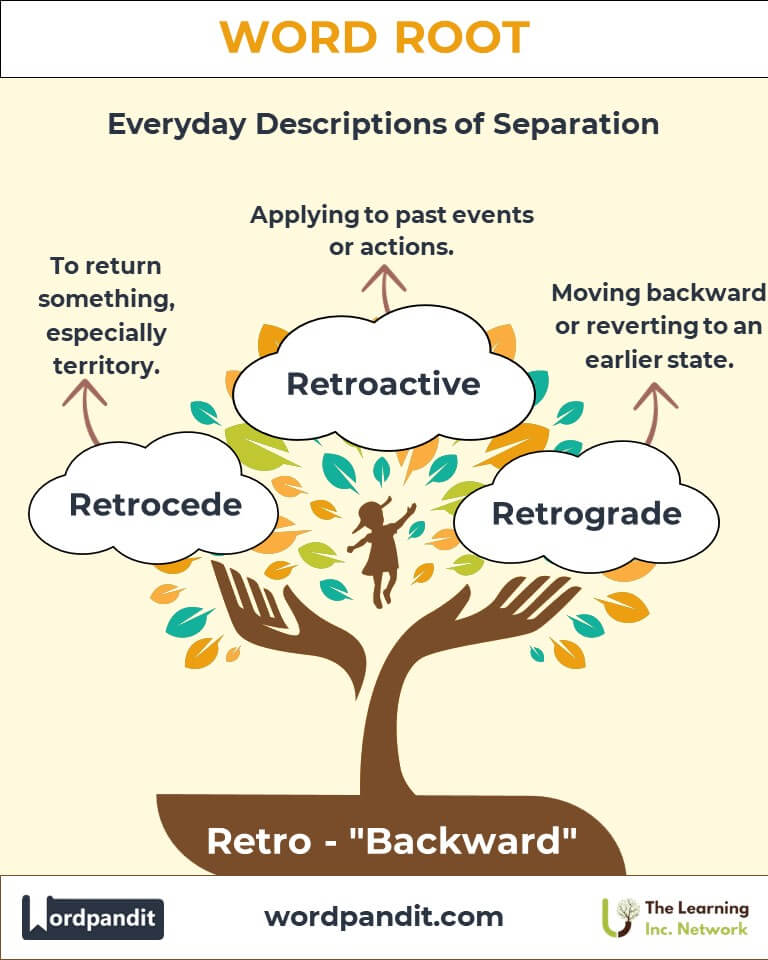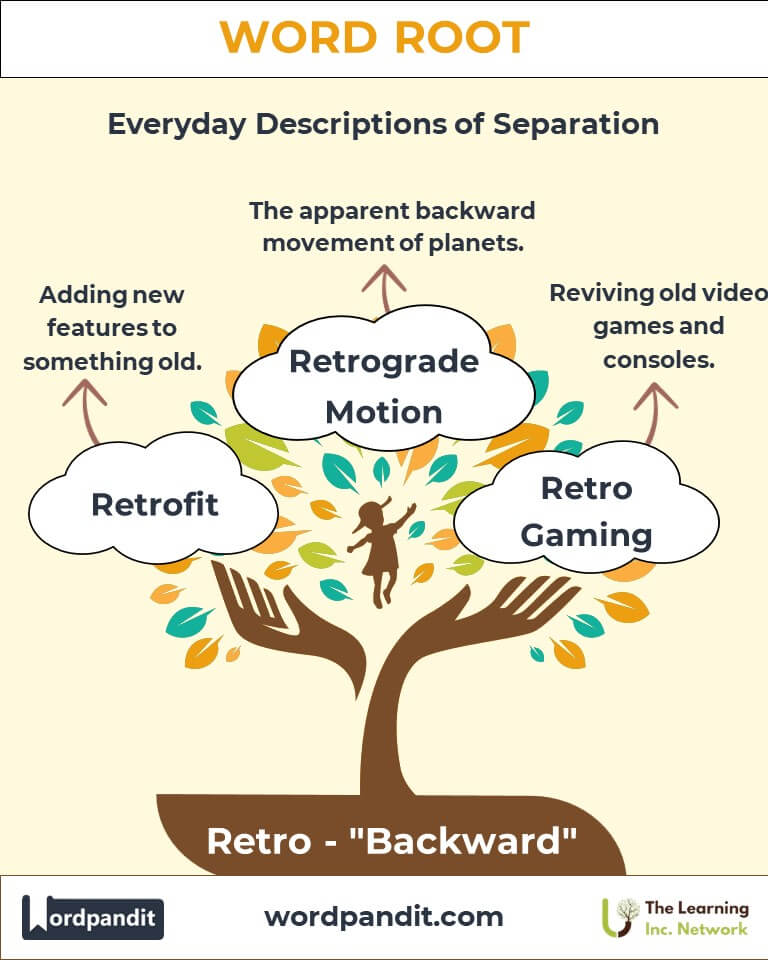Retro: Exploring the Past to Shape the Present and Future
Dive into the fascinating world of the root "Retro," originating from Latin and meaning "backward." From words like "retroactive" to "retrospect," this root captures the essence of looking back and understanding the past to inform our actions in the present and future.

Table of Contents
- Introduction: The Essence of Retro
- Etymology and Historical Journey
- Mnemonic: Unlocking the Power of Retro
- Common Retro-Related Terms
- Retro Through Time
- Retro in Specialized Fields
- Illustrative Story: Retro in Action
- Cultural Significance of Retro
- The Retro Family Tree
- FAQs About the Retro Word Root
- Test Your Knowledge: Retro Word Root Quiz
- Conclusion: The Living Legacy of Retro
1. Introduction: The Essence of Retro
What comes to mind when you hear the word "retro"? Perhaps vintage fashion, nostalgic music, or even the charm of classic cars. The root "Retro," pronounced reh-tro, comes from Latin, meaning "backward." Its influence extends far beyond nostalgia, embodying the idea of looking back to better understand the present. From law ("retroactive") to reflection ("retrospect"), "Retro" enriches our understanding across diverse fields and concepts.

2. Etymology and Historical Journey
The root "Retro" stems from the Latin prefix retro- meaning "backward" or "in past times." Initially used in ancient texts to denote a literal or figurative backward motion, its usage expanded during the Renaissance, reflecting the era's reverence for revisiting classical art and knowledge. Over time, the term became associated with cultural and intellectual movements emphasizing the importance of the past.
3. Mnemonic: Unlocking the Power of Retro
Imagine pressing the rewind button on a movie to revisit a critical scene. "Retro" is like this rewind button—taking us back to understand what came before.
“Retro is your rewind to reflect and learn.”
4. Common Retro-Related Terms
- Retroactive: Applying to events or actions that occurred in the past. Example: "The government introduced a retroactive tax affecting last year's earnings."
- Retrospect: The act of looking back on past events. Example: "In retrospect, she realized her decision shaped her career."
- Retrofit: To add new features to something old. Example: "The old building was retrofitted with solar panels."
- Retrograde: Moving backward or reverting to an earlier state. Example: "The retrograde motion of the planet puzzled ancient astronomers."
- Retrocede: To return or yield something, especially territory. Example: "The land was retroceded to its original owners."
5. Retro Through Time
- Retroactive (Law and Policy): Historically, retroactive laws have sparked debates about fairness, such as applying new standards to past actions.
- Retrofit (Engineering): In the 20th century, retrofitting emerged as a critical practice for preserving historic architecture while incorporating modern functionality.
6. Retro in Specialized Fields
- Law:
- Retroactive Legislation: Laws applied to actions taken before the law was passed. Example: "Retroactive policies often impact tax codes or legal rulings."
- Astronomy:
- Retrograde Motion: Describes planets that appear to move backward due to orbital mechanics. Example: "Retrograde motion helped early scientists understand the heliocentric model."
- Fashion:
- Retro Trends: Styles from previous decades making a comeback. Example: "The 1980s retro trend is popular in contemporary fashion."
- Technology:
- Retro Gaming: Reviving old video games and consoles for modern audiences. Example: "Retro gaming communities celebrate classics like Pac-Man and Tetris."
7. Illustrative Story: Retro in Action
A young entrepreneur named Lily admired vintage design and decided to launch a retro-themed café. She curated 1960s furniture, retrofitted an old building with modern amenities, and offered a menu inspired by mid-century cuisine. In retrospect, her attention to blending the past with the present brought in customers longing for nostalgia and comfort.
8. Cultural Significance of Retro
"Retro" embodies a deep cultural appreciation for the past. From music and fashion to art and philosophy, retro movements serve as reminders that history shapes identity. In modern times, retro themes symbolize a yearning for simplicity amidst rapid technological change.

9. The Retro Family Tree
- Re- (again, back):
- Replay: To play again.
- Revisit: To visit again.
- Post- (after):
- Postmortem: After death analysis.
- Pre- (before):
- Prehistoric: Before recorded history.

FAQs About "Retro"
Q: What does the root "Retro" mean?
A: "Retro" is a Latin root meaning "backward" or "in past times." It implies motion or thinking directed toward the past and is used to describe concepts, movements, or actions focused on revisiting or applying ideas, styles, or policies from earlier times.
Q: What is "Retroactive," and how is it used?
A: "Retroactive" refers to applying a law, decision, or effect to events or actions that occurred in the past. For example, if a new tax law becomes retroactive, it might impact earnings made before the law was enacted. It can be contentious in legal or political contexts as it changes the rules for past actions.
Q: What does "Retrospect" mean, and when is it used?
A: "Retrospect" means looking back or reflecting on past events. It is often used when evaluating decisions or actions after some time has passed, enabling analysis of their outcomes. For instance, "In retrospect, choosing to pursue further education was the best decision of my life."
Q: What is the difference between "Retrograde" and "Retroactive"?
A: "Retrograde" refers to moving backward or reverting to an earlier state, often used in astronomy (e.g., "retrograde motion of planets") or to describe a decline in quality. "Retroactive," on the other hand, applies to laws or decisions impacting past events, such as "retroactive pay increases."
Q: How is "Retrofit" different from renovation or rebuilding?
A: "Retrofit" specifically refers to adding new features or updating existing systems within an old structure or machine. For example, retrofitting a historic building might involve installing energy-efficient windows without altering the original design.
Test Your Knowledge: "Retro" Mastery Quiz
1. What does the root "Retro" signify?
2. What does "Retrofit" mean?
3. Which field uses "Retrograde" to describe motion?
4. What is an example of a retro trend?
5. What does "Retrospect" mean?
12. Conclusion: The Living Legacy of Retro
The root "Retro" captures the timeless value of reflecting on the past to shape our present and future. Whether through language, culture, or technology, it connects us to history and its enduring lessons. Let "Retro" inspire you to appreciate the richness of the past while innovating for tomorrow.












